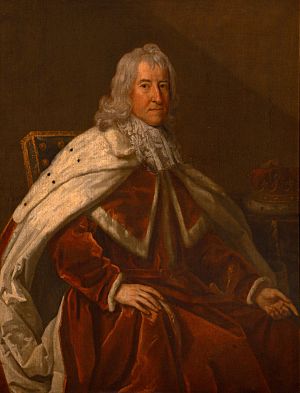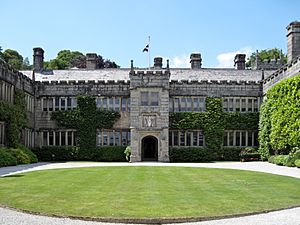John Robartes, 1st Earl of Radnor facts for kids
Quick facts for kids
The Earl of Radnor
|
|
|---|---|

Portrait by Godfrey Kneller
|
|
| Lord President of the Council | |
| In office 24 October 1679 – 24 August 1684 |
|
| Monarch | Charles II |
| Preceded by | The Earl of Shaftesbury |
| Succeeded by | The Earl of Rochester |
John Robartes, 1st Earl of Radnor (1606 – 17 July 1685) was an important English politician, a noble (called a peer), and a military leader. He fought for the Parliament during the English Civil War. This war was a big conflict between those who supported the King and those who supported Parliament.
John Robartes stepped away from public life before King Charles I was put on trial and executed in 1649. He didn't get involved in politics again until after the Restoration in 1660. This was when the monarchy was brought back to England.
During the reign of King Charles II, John Robartes disagreed with the "Cavalier party." This group supported the King and the official Church of England. John wanted more freedom for different religious groups that were not part of the Church of England. Later in his life, he also opposed some extreme Protestant groups. These groups, led by Anthony Ashley Cooper, 1st Earl of Shaftesbury, did not want James to become king because James was Catholic.
Early Life and Family
John Robartes was born in Truro, England. His father, Richard Robartes, became a knight in 1616. He was then made a baronet in 1621 and a noble (Baron Robartes of Truro) in 1625. A baronet is a special title, like a knight but passed down through the family.
The Robartes family became very rich by trading in tin, wood, and gorse (a thorny bush). These materials were important for melting tin. In 1620, they bought and started making Lanhydrock House bigger. This large house near Bodmin became their main family home. Richard bought his noble title for £10,000 in 1625. Some people who opposed the Duke of Buckingham claimed that Richard was forced to buy this title.
John was the first in his family to go to university. He studied at Exeter College, Oxford. His father became friends with Robert Rich, 2nd Earl of Warwick. This friendship led to John marrying the Earl's younger daughter, Lucy. This marriage connected John to powerful religious leaders who had strong, new ideas.
Fighting in the Civil War
John Robartes believed in the ideas of Calvinism, which was a strict form of Protestantism. He became worried about King Charles I's religious policies, which seemed to favor a different religious view called Arminianism. John also thought the King was becoming too powerful and ruling like a dictator. He believed the King was being advised by bad people.
Because of these beliefs, John Robartes fought for Parliament during the English Civil War. He believed he was also fighting for the true interests of the King. He showed great bravery in battles, including the Battle of Edgehill in October 1642 and the First Battle of Newbury in September 1643.
He became a member of the Committee of Both Kingdoms. This committee included his mentors, the Earls of Warwick and Essex. Being on this committee helped him understand Scottish Presbyterianism, another Protestant faith. John always read the Bible and thought about its meaning himself. His notes in his books show he believed that faith was more important than religious ceremonies. He became Baron Robartes in May 1634 after his father, Richard, passed away.
Some people say that John convinced the Earl of Essex to march into Cornwall in 1644. This march ended badly for Parliament's army. John escaped with the Earl from Fowey after the defeat. He then safely reached Plymouth and became its Governor. He successfully defended Plymouth from the Royalist army that was trying to capture it.
In April 1645, a rule called the Self-Denying Ordinance meant that John lost his military command in Plymouth. Like his brother-in-law, the Earl of Manchester, he had to watch from the sidelines as Oliver Cromwell's New Model Army won many victories. John and other nobles who had supported Parliament were pushed aside by a group called the Independents. These Independents did not want to keep talking with King Charles. John would have been shocked by the King's execution.
Later Life and Public Service
After King Charles I was executed and before King Charles II returned in 1660, John Robartes lived quietly at Lanhydrock with his family. He did not take part in public life during this time. He seemed to spend most of his time studying and raising his growing family.
After 1660, he became a very important public figure. He had influence among the Presbyterians. He also sided with those who opposed Edward Hyde, 1st Earl of Clarendon, a powerful advisor to the King. John Robartes sometimes faced criticism for being slow, arrogant, or bad-tempered.
He was offered the job of Lord Deputy of Ireland in 1660 but did not want it. He later served as Lord Lieutenant of Ireland from 1669 to 1670. From 1661 to 1673, he was the Lord Privy Seal, a high government position, though he didn't do much in this role after returning from Ireland. He then retired again to Lanhydrock, where he enjoyed hunting deer and hare in his large parks. He also became a Fellow of the Royal Society in 1666, which is a group for important scientists.
In 1679, King Charles II asked John Robartes to return to public office. The King wanted his help to balance the growing power of the Whigs. The Whigs were a group who did not want the King's brother, James, Duke of York, to become king because James was Catholic.
In 1679, because he supported King Charles's plan for his brother to be the next king, John was made Lord President of the Council. This was a very high position. He was also given new noble titles: Viscount Bodmin and Earl of Radnor. He served as President until 1684 and continued to attend the House of Lords (part of Parliament) until a few weeks before he died. John Robartes passed away in Chelsea on 17 July 1685.
He was buried in the family tomb at Lanhydrock Church. He had asked for a simple burial in his will.
Family Life
John Robartes was married twice. His first wife was Lucy Rich. They had three sons, including Robert and Hender. His second wife was Letitia Isabella (who died in 1714). They had nine other children, including Francis and Araminta. Araminta married Ezekiel Hopkins, who was a Bishop.
John Robartes' oldest son, Robert, Viscount Bodmin, was an ambassador to Denmark in 1681. He died there in February 1682. Robert had married Sarah Bodvel. Her father was not happy about this marriage because he didn't give his permission. Because of this, he decided not to leave his wealth to Sarah, but to a distant cousin instead.
The title of Earl of Radnor later went to Robert's son, Charles (1660–1723). Charles is mentioned by the famous writer Jonathan Swift in his Journal to Stella. Charles managed to get back the family wealth that had been lost. The title of Earl of Radnor ended when the fourth earl, John Robartes (1686–1757), died. He was the eldest son of Francis Robartes.
|


